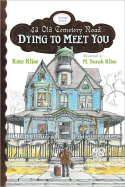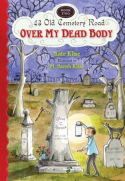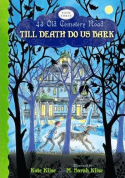43 Old Cemetery Road is a quirky illustrated series for children that tells its ghostly story using letters, newspaper clippings, drawings, et cetera. There are three books in the series so far—Dying to Meet You (2009), Over My Dead Body (2009), and Till Death Do Us Bark (2011)—with a fourth (The Phantom of the Post Office) due in May 2012.
Dying to Meet You
 What with the illustrations and the fact that the story is told through correspondence rendered in a large font, Dying to Meet You is a very quick read. And yet, for all that, it’s got some nuance!
What with the illustrations and the fact that the story is told through correspondence rendered in a large font, Dying to Meet You is a very quick read. And yet, for all that, it’s got some nuance!
Ignatius B. Grumply is a famous children’s author who hasn’t written anything for twenty years. Seeking to overcome his writer’s block, he rents a Victorian house in Ghastly, Illinois and is decidedly miffed to discover a boy and his cat living there. The boy, Seymour Hope, has been left behind by his parents, the owners of the home, who are on a lecture tour of Europe. They’re paranormal experts, and had moved into Spence Mansion hoping to confirm the existence of its rumored spectral resident. When Seymour could see her, but they couldn’t, they became convinced that a) ghosts don’t exist and b) their son is delusional.
But Olive C. Spence, the ghost of the woman who originally built the house, is indeed real! She sets out to drive Ignatius away at first, but after an incident with a chandelier causes more injury than she had intended, she begins to feel sorry for him and decides to help him with his book. It turns out that all of them have been rejected in one form or another: Seymour by his parents, Olive by the publishers who would never give her graphic epistolary mysteries a chance, and Ignatius by the woman he loved and upon whom he squandered his fortune.
Olive encourages “selfish and crabby” Ignatius to feel and care about others again, and thus achieves a warm and fuzzy ending where each of them gets something they want while drawing together into their own little family. It’s quite sweet, really. About the only complaint I could make is that some of the punny names are not funny—Paige Turner, Frank N. Beans, Shirley U. Jest—but I did have to snicker at Fay Tality and her dog, Mort, so they’re not all clunkers.
Over My Dead Body
 Life at 43 Old Cemetery Road has been great since Ignatius, Olive, and Seymour began collaborating on a series of ghost stories. When a letter from Dick Tater, head of the International Movement for the Safety & Protection of Our Kids & Youth, arrives, however, everything is turned upside down. Tater objects to their living arrangements, especially the fact that custody of eleven-year-old Seymour was seemingly transferred via a rental lease, and his investigation results in Ignatius being committed to an asylum and Seymour being sent to an orphanage until his opportunistic parents deign to claim him.
Life at 43 Old Cemetery Road has been great since Ignatius, Olive, and Seymour began collaborating on a series of ghost stories. When a letter from Dick Tater, head of the International Movement for the Safety & Protection of Our Kids & Youth, arrives, however, everything is turned upside down. Tater objects to their living arrangements, especially the fact that custody of eleven-year-old Seymour was seemingly transferred via a rental lease, and his investigation results in Ignatius being committed to an asylum and Seymour being sent to an orphanage until his opportunistic parents deign to claim him.
The majority of the book is comprised of letters to and from Olive as everyone ponders how to escape confinement and satisfy the customers who have prepaid for the next three installments of their story. Dick Tater does various nefarious things, like canceling Halloween and instructing libraries to burn books that meet with his disapproval, and the book has a very pro-reading, pro-free thinking vibe as a result.
The book also features the second “just go with it” moment of the series. I assume this is going to be a recurring thing. In the first book, readers had to “just go with” the stipulation that sales of the trio’s stories (at $3 a pop, if I recall rightly) were sufficient to raise the $250,000 Seymour needed to buy Spence Mansion from his parents. Here, Ignatius and Olive (a ghost, mind you) are able to adopt Seymour simply by proving his parents don’t love him.
To this I say, “Whatever.” I am willing to go with it because it results in (nicely illustrated) passages like this, which I confess made me a bit verklempt. (Best attempted after you remind yourself of Seymour’s last name.)
And so, in a sense, we end where we began… in a 32½-room house built by a woman who, in her lifetime, never married or had children… and rented by a man who never married and always thought he disliked children… and purchased by a boy whose parents abandoned him. And so, even though one member of the family might still get grumpy now and then… and another might become cranky when she misplaces her glasses… neither would ever, could ever, abandon Hope.
Sniff.
Till Death Do Us Bark
 One day, a shaggy dog follows Seymour home from the library. He has always wanted a dog, and so he asks his new parents, Ignatius and Olive, if he can keep him. They have reservations, and insist that he first attempt to find the dog’s owner, since he has a collar and everything. Seymour soon learns that the dog formerly belonged to Noah Breth, a wealthy man who recently died and whose children (Kitty and Kanine) are bickering over their presumed inheritance. But he doesn’t tell his parents this.
One day, a shaggy dog follows Seymour home from the library. He has always wanted a dog, and so he asks his new parents, Ignatius and Olive, if he can keep him. They have reservations, and insist that he first attempt to find the dog’s owner, since he has a collar and everything. Seymour soon learns that the dog formerly belonged to Noah Breth, a wealthy man who recently died and whose children (Kitty and Kanine) are bickering over their presumed inheritance. But he doesn’t tell his parents this.
I must say that I did not like this book as well as the others. I like that Seymour admits that his goal was to be a perfect son, but that very quickly he was keeping secrets and running away. What I don’t like was how he was so passionately dog crazy when his best friend up ’til now has been his cat, Shadow. He didn’t show much concern that Shadow had seemingly run away after the dog showed up. And Ignatius, who is allergic to cats, suddenly had a flare-up and pledged to “get rid” of the cat once it was found. This is not the way to endear me to your characters, Klise sisters.
Of course, everything works out fine in the end and Shadow is nearby and well. The Breth siblings, who have been following a series of limericks devised by their late father on the hunt for his fortune, are shamed into suddenly becoming nicer people. A rare coin that everyone’s been looking for turns out to be exactly where it was telegraphed to be at the beginning of the story.
As a result, more than the other books, this one feels like something only children would enjoy. I hope the upcoming fourth book represents a return to form.




Speak Your Mind